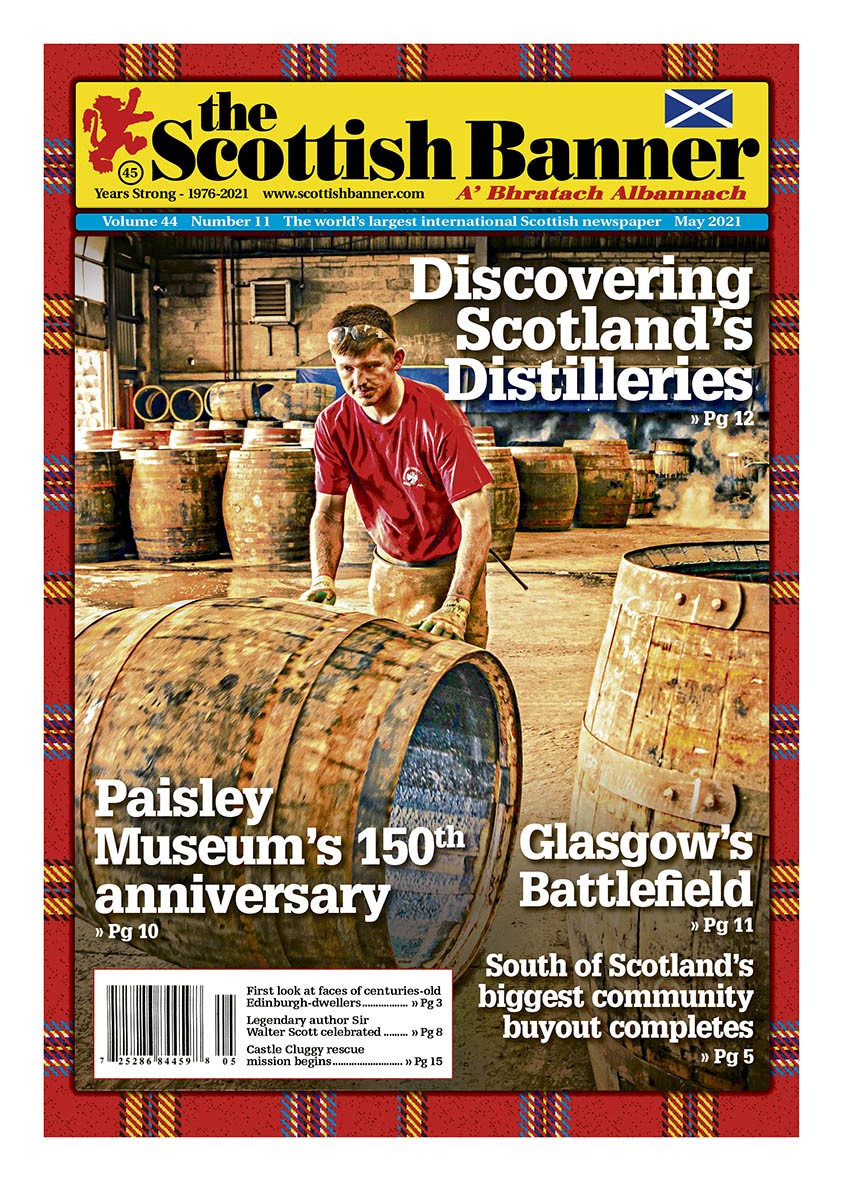May 2021 (Vol. 44, Number 11)
-

Gracing our cover: The ancient art of coopering at The Speyside Cooperage. Photo: VisitScotland/North East 250/Damian Shields.
The Banner Says…
The Water of Life
It is said Mark Twain once made the famous comment “Too much of anything is bad, but too much good whisky is barely enough.”
May in Scotland is traditionally Whisky Month, with events taking place across the five whisky regions (Highland, Lowland, Speyside, Islay and Campbeltown) of the country. This year of course things may not be back to normal with the slow and measured opening of Scotland, however virtual events will ensure whisky aficionados are certain to still find ways to celebrate Uisge beatha, the Scottish Gaelic term for water of life. As we hit mid-month a global celebration also takes place with World Whisky Day on May 15th.
Each bottle of whisky produced tells a story
Each bottle of whisky made in Scotland certainly tells a story of the local region in which it was produced. From smokey and peaty Islay malts to the light bodied varieties from the Lowland’s. With over 130 distilleries to be discovered across Scotland you can be just about anywhere and find some liquid gold being produced.
This year alone Scotland is expected to open new distilleries in Loch Lomond, John O’Groats and Falkirk to name a few, with work being planned on future locations such as Edinburgh, Speyside, Islay and the Scottish Borders.
Some may also be surprised to learn of the reported health benefits which come with consuming whisky, at moderation of course! Whisky is said to help with some surprising ailments so raising a dram just may be good for you. Whisky can lower your risk of heart
disease, promote weight loss, help fight cancer, reduce blood clots, aid digestion and of course help with a common cold by having a Hot Toddy.
In this issue
To help celebrate Whisky Month we have featured just some of the great distilleries you can visit when it is safe to next travel to Scotland. Apart from sampling a dram many distilleries also tell a great story and have strong historical links to the local community. Scotland’s distilleries come in all shapes and sizes, from large ones with modern displays and interactive exhibits explaining the process, to small ones which have preserved their distilling techniques and secrets since the 18th century.
The town of Paisley can be missed from people’s itineraries when visiting Scotland. It however is the largest town in Scotland and is only a short trip by train or car from Glasgow and has much to boast about. Paisley’s growth in the early 19th century was mainly through textile production and the name Paisley was given to the Kashmiri pattern of curving shapes found on silk and cotton fabric. Paisley Museum is being transformed into a world-class destination which will retell the town’s story to the world and is looking for the world to share their paisley history with them.
The most significant battle to take place within Glasgow was fought in the southside of the city on May 13, 1568 and was the Battle of Langside. The Catholic Mary, Queen of Scots was overwhelmingly defeated by Protestant forces after which she fled to England where she was incarcerated by her royal rival and distant cousin Elizabeth I and eventually executed.
The dram of Scotland
The first recorded evidence of whisky production in Scotland dates back to 1494 when monks made Aqua Vitae, as whisky was then known, in Fife. It is suspected however the tradition of whisky making pre-dates this, but one thing that is certain is that whisky production is very much a part of Scotland’s culture, industry and psyche.
As whisky began to be known across the country Scottish farmers would distil their surplus grain at the end of the harvest season to make the ever-popular drink. This led to the government imposing a whisky tax in 1644, which caused many a distiller to go underground and an illicit distilling and whisky smuggling boom was born. For well over 100 years canny Scots mixed farming and distilling with great skill, creating a network of stills and distribution to evade customs.
Today whisky is one of Scotland’s top exports with hundreds of countries around the world wanting and consuming the dram of Scotland. It is now an industry that is worth over billion’s to Scotland and has fans across the globe.
I hope you are able to sit back and enjoy your May and if that involves having a wee dram, here is to your good health! Cheers/Slàinte Mhath!
Have you visited one of Scotland’s great distilleries? Do you have a favourite dram? Do you have you any comments from the content in this month’s edition? Share your story with us by email, post, social media or at: www.scottishbanner.com/contact-us
#ScottishBanner, #TheBanner
Covid-19 is having a major impact on many of our regular advertisers, with events being cancelled and businesses suffering. The Scottish Banner is more reliant than ever on our readers helping us to provide you with our unique content by buying a copy of our publication, regardless if by print or digital subscription or at a retail outlet.
We appreciate your support and hope you enjoy this edition.
